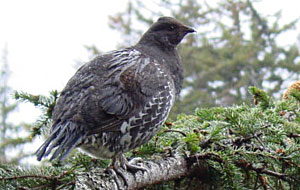Small Game Hunting in Alaska
Small Game Species — Sooty Grouse
Sooty Grouse
(Dendragapus fuliginosus)
Habitat
The wet, evergreen forests of Southeast Alaska from Haines to Ketchikan are the home of Alaska’s biggest grouse, the sooty grouse or "hooter." Practically every island and cape has a population of these fine birds, although, oddly enough, there are no authentic records from Prince of Wales Island. Big timber is important to sooty grouse, as it provides food and shelter in the winter months. Muskegs and alpine meadows are equally essential for the superior summer and fall feeding areas they offer. Hens with their chicks seem particularly fond of sunlit forest edges.
Identification
 The male sooty grouse, tipping the scales at 3 pounds, is a handsome bird, with its yellow comb standing out against the slaty
blue of the head, and with its long black tail tipped with pale gray. The females are browner than the males, and are slightly
more that two-thirds their size.
The male sooty grouse, tipping the scales at 3 pounds, is a handsome bird, with its yellow comb standing out against the slaty
blue of the head, and with its long black tail tipped with pale gray. The females are browner than the males, and are slightly
more that two-thirds their size.
Behavior
Many people have heard the "boy-with-the-empty-cider-jug" hooting of sooty grouse that begins soon after mid-March, when the males are concentrated in the upper half of the timbered zone of the mountains.
Nests are almost always outside male territories. Hens usually lay five to nine eggs in a shallow depression scratched out in the forest floor. Most nests have overhead cover of small conifers, shrubs, rock overhangs, or logs, but in old-growth forest may be at the base of a large tree. Males do not assist females and remain alone within their territories through the summer. In late June, sooty grouse hens with their downy chicks frequent the edges of muskegs, logged areas, and roads. In August and September, deer and goat hunters begin to see families of sooty grouse, with the chicks well grown, in the alpine meadows near timberline, almost in ptarmigan country. Birds move onto winter range of mature conifer forest by November. Males may remain alone or form into small groups of three to six birds. Females with their broods often form into small flocks of up to 10 (occasionally to 20) birds.
Extensive clear-cut logging of old-growth forest in Southeast Alaska has resulted in lower sooty grouse densities in those areas. The introduction of marten onto Baranof Island has also had a negative effect on sooty grouse numbers there.
 Sooty grouse have considerable potential as game birds, especially in late winter and early spring. Stalking the cocks while they
are calling from the treetops can offer quite a challenge since it entails climbing up to timberline, often through deep snow,
trying to spot the birds 75–100 feet up in trees, and pinpointing their location given the ventriloquist effect of their calling.
The Department of Fish and Game has recognized the recreational benefits from this unique type of hunting, and has extended the
open season to include at least a month of the hooting period of male sooty grouse.
Sooty grouse have considerable potential as game birds, especially in late winter and early spring. Stalking the cocks while they
are calling from the treetops can offer quite a challenge since it entails climbing up to timberline, often through deep snow,
trying to spot the birds 75–100 feet up in trees, and pinpointing their location given the ventriloquist effect of their calling.
The Department of Fish and Game has recognized the recreational benefits from this unique type of hunting, and has extended the
open season to include at least a month of the hooting period of male sooty grouse.
Sooty grouse eat many berries in August and September, as well as other vegetation, but soon afterward change to a diet of conifer needles. Sitka spruce and both western and mountain hemlock provide most of the food of these grouse until May, when fresh growth again is available. The adaptability of the digestive tract of these grouse is amazing, considering the rapid change in fall from a succulent diet of berries to the dry, fibrous fare of evergreen needles. There is a tremendous seasonal turnover in the kinds of bacteria in the intestines that do most of the conversion of incoming food to usable nutrients.
Where to Find Them
Sooty grouse can be found in spring within easy walking distance of Juneau, Petersburg, and Ketchikan or along the road systems near those towns. Many trails maintained by the U.S. Forest Service turn the formidable task of hiking into their habitat in Southeast Alaska into a real pleasure.
Range of the Sooty Grouse in Alaska
Alaskans know sooty grouse as birds of the dense coastal forests of the panhandle where, in the summer, they range into alpine meadows and lowland muskegs. Throughout its range, the sooty grouse spends winters in habitat dominated by conifers.

